"Just sold #xrp , and today I'm kicking myself—how high is this coin going to rise?" Recently, similar wails have been heard all over the crypto community.#山寨币突破
On July 17, when the U.S. House of Representatives overwhelmingly passed the (GENIUS Act) with a vote of 308:122, XRP's price shot up like a firecracker: from $2.29 on July 9 to $3.48 on July 17, soaring 51% in four days, easily surpassing the previous high of $3.4 from 2021 and even touching the edge of the 2018 bull market peak 📈#山寨季何时到来? .
This is not just an ordinary "positive news stimulus"—as the SEC's regulatory shadow gradually recedes, as Ripple's strategic layout begins to take shape, and as on-chain data collectively shouts "the bull is coming," we may be witnessing XRP's historic leap from "controversial asset" to "core hub of dollar digital infrastructure."
First, the policy nuclear bomb detonated: XRP has finally received the "compliance get-out-of-jail-free card."
If the 2020 dispute over Ripple and the SEC's "classification of securities" was the Damocles sword hanging over XRP for three years, then the passage of the (GENIUS Act) is the sound of that sword being completely shattered.
Which interests have been affected by this bill, known as the "starting point of the crypto dollarization system"? And what sword has been handed to XRP?
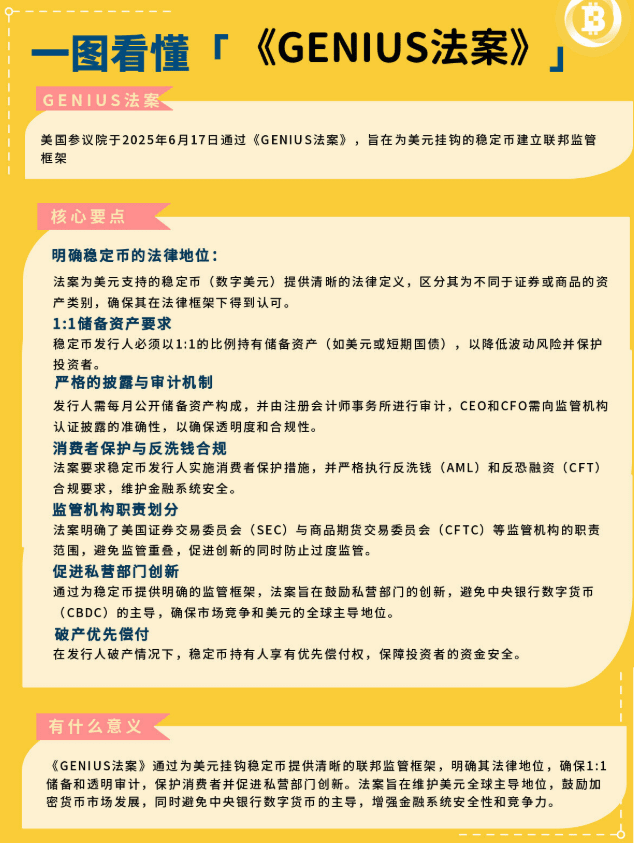
In simple terms, it has fitted "payment-type stablecoins" with three layers of protection:
✅ 100% reserve hard constraints: stablecoins must be fully backed by cash and short-term government bonds, completely eliminating "air coins" style over-issuance;
✅ Federal licensing system: only institutions certified by the OCC (Office of the Comptroller of the Currency) or the Treasury can issue coins, significantly weakening the SEC's "classification of securities" authority;
✅ Transparent auditing + user priority: reserve assets are managed by licensed custodians like BNY Mellon, with user assets prioritized during settlement.
The most critical thing is—
The act clearly seized regulatory control from the SEC! It’s important to note that in the past, the SEC categorized most crypto assets as "securities," leaving XRP in a long-standing controversy over "whether it is illegal financing." Now, the (GENIUS Act) directly draws the line: payment-type stablecoins are under the jurisdiction of the Treasury and OCC, unrelated to "securities!"
What does this mean?
Ripple's four-year lawsuit with the SEC has seen a surge in winning probability; XRP, as a "non-stablecoin but a bridge asset connecting stablecoins," can finally conduct compliant business in the light; the entire crypto payment sector is set to completely transition from the "grey area" to "national infrastructure."
Even former U.S. Treasury Secretary Summers couldn't help but comment:
"This is not simple regulation; it is the U.S. seizing the global dominance of digital dollars—and XRP may be the first to eat the crab."
Second, Ripple's covert strategy: from "cross-border remittance company" to "digital infrastructure provider for the dollar."
When the policy wind blows, Ripple has long been quietly preparing big moves.
In May of this year, when outsiders were still debating XRP's legal status, Ripple quietly rolled out a game changer—its self-developed stablecoin $RLUSD.
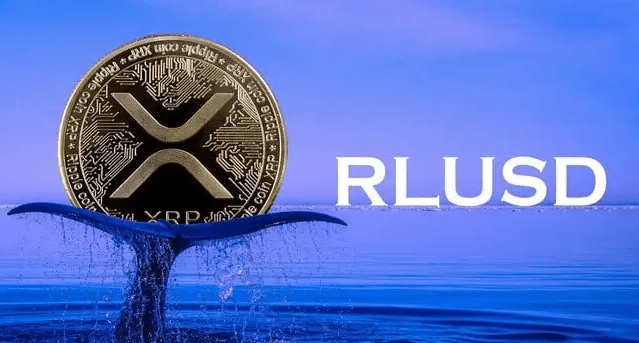
This thing is not simple:
🌐 Cross-chain circulation: running simultaneously on XRP Ledger and Ethereum, naturally adapting to a multi-chain ecosystem;
🏦 Hardcore custody: reserves locked in century-old banks like BNY Mellon, safer than the foreign exchange reserves of many countries;
🔑 Pre-adapted to new regulations: designed from the ground up to align with the (GENIUS Act), applying for a federal license directly through the "green channel."
Moreover, Ripple has already submitted a compliance qualification application to the OCC—if all goes well, it will become one of the first "licensed stablecoin issuers" in the U.S.
What does this operation amount to?
Previously, Ripple was the "tool for banks to use XRP for cross-border remittances"; now it has directly upgraded to a "provider of digital dollar network infrastructure." Just like how Alipay transformed from "payment tool for Taobao" to "digital financial infrastructure," XRP's role has evolved from "transfer fuel" to "the expressway connecting all stablecoins and CBDCs (central bank digital currencies)."
Ripple CEO Brad Garlinghouse stated plainly: "We never aimed to replace the dollar, but to make the dollar flow faster and cheaper on-chain—XRP is the 'on-chain lubricant' for the dollar."
Now looking at XRP's surge, it is not merely emotional speculation; it is clearly the market reassessing the value of "core assets of dollar digital infrastructure!"
Third, on-chain data proves: this is not "a pump and dump," it is "real money entering the market."
Of course, having policies and corporate actions is not enough; on-chain data is the most honest "market translator."
🔥 The price is surging rapidly:
From July 9 to 17, XRP achieved a 51% increase in just 8 days, not only breaking the psychological barrier of $3 but also reaching an all-time high of $3.48 (the peak in January 2018 was $3.4).
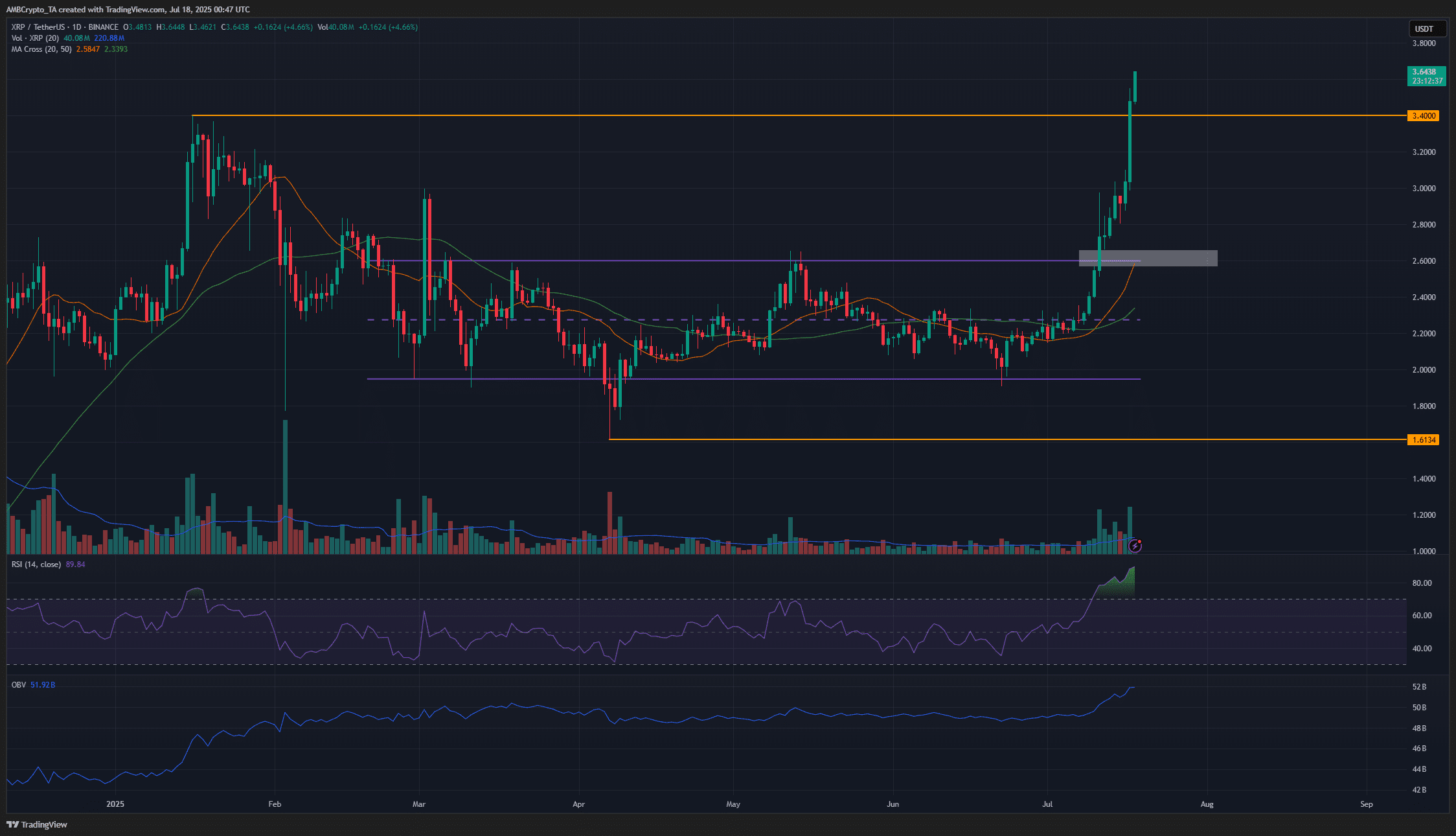
More crucially, this rise is accompanied by a surge in trading volume—Coingecko data shows that on July 17, the daily trading volume exceeded $1.5 billion, more than three times the usual.
📊 On-chain indicators are showing positive signs:
Number of wallet addresses: the number of independent addresses holding XRP has surpassed 12 million, reaching a new high since 2021;
Holding distribution: the number of whale addresses (holding over $1 million in XRP) has increased by 23%, indicating that large funds are continuously accumulating;
OBV energy wave: the energy wave indicator has been rising for 15 consecutive days, which is a typical signal of "continuous capital inflow," suggesting that the bullish trend is far from over.
What excites the technical crowd the most is the movement of the MVRV ratio—this indicator measuring "the actual cost of investors versus the current market value" has recently broken through the 200-day moving average. Historical data shows that the last time MVRV broke through the 200-day moving average, XRP surged 630% in the following 6 months!
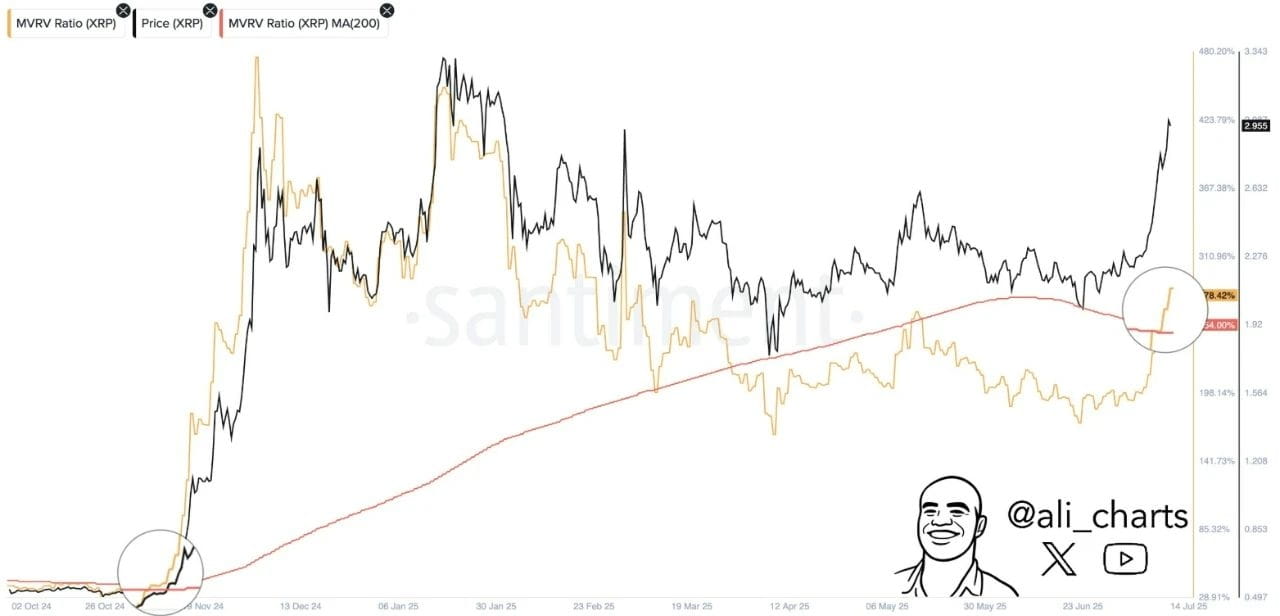
"Today's XRP is like ETH before the launch of DeFi summer in 2020," crypto analyst Ali Martinez bluntly stated on Twitter, "with policy dividends + technical breakthroughs + capital inflow, the historical new high is just an appetizer."
Fourth, XRP's "second spring": from "controversial coin" to "digital dollar hub."
If the XRP surge in 2017-2018 was driven by "ICO bubble-induced emotional frenzy," and the rebound in 2021 was a "benefit from the DeFi craze," then this rise is fundamentally a "value discovery of dollar digital infrastructure."
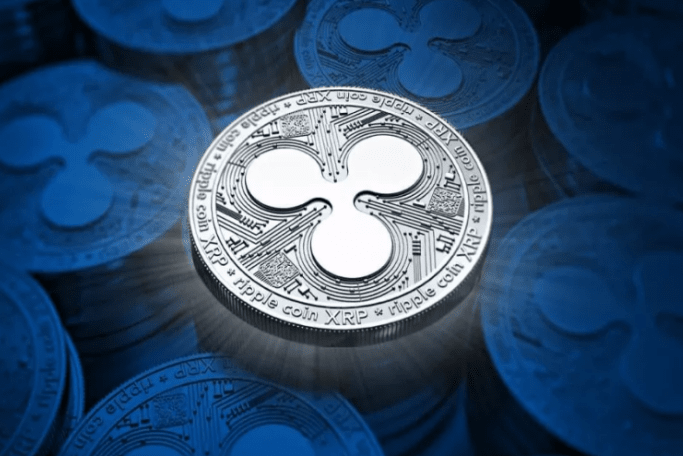
After the implementation of the GENIUS Act, U.S. trading platforms will only allow stablecoins that meet the standards (such as RLUSD, USDC) to be listed. But how will these stablecoins be exchanged? How will CBDCs (like future digital RMB, digital euro) connect to the dollar system? At this point, a "middleware" is needed—a "bridge" that can cross chains, quickly settle, and connect different assets.
And XRP is precisely tailored for this scenario:
⚡ Fast enough: XRP Ledger's transaction confirmation time is only 3-5 seconds, much faster than Bitcoin's 10 minutes and Ethereum's 15 seconds;
💸 Low cost: each transaction fee is only 0.00001 XRP (about $0.0003), almost zero cost;
🌍 Strong compatibility: natively supports cross-chain protocols and can seamlessly connect major public chains such as Ethereum, Solana, and TRON.
In other words, in the future when you buy a cup of coffee with USDC or exchange digital euros for digital dollars, XRP might be quietly settling behind the scenes—it’s like the TCP/IP protocol of the internet era; although invisible, all data flow relies on it.
Written in conclusion: the story of XRP has just turned a new chapter.
From being chased by the SEC to becoming the core asset of dollar digital infrastructure; from "an incomprehensible cross-border payment tool" to "the expressway of on-chain dollars"—XRP has achieved a textbook-level "comeback" in 8 years.
The question now is not "how much higher can XRP go," but "do you understand the changes that are happening?" When policy winds, corporate strategies, and on-chain data create a perfect resonance, and when the value of the "bridge asset" begins to be reassessed by the market, we may be witnessing the dawn of a new era—and XRP is the "infrastructure stock" of this era.
Lastly, a reminder: the crypto market is always volatile, but this time is different—the story of XRP has upgraded from "speculative trading" to "participating in the construction of the dollar digital empire."
✍️ Do Your Own Research (DYOR), manage risks well, and may everyone set sail in the crypto world! 🌊
🔁 Feel free to like and share with your crypto friends, and don't forget to follow me for more insights into the latest developments in the crypto world!
💬 If you have any projects you want to discuss, feel free to join us! Let's explore the crypto world together, and cheer each other on! 😎
